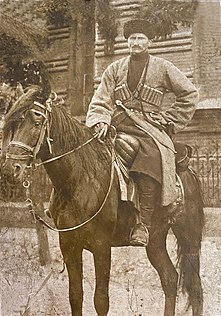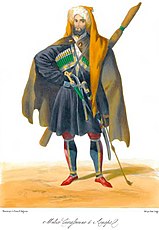A chokha[a] also known as the cherkeska[2] is a woolen coat with a high neck that is part of the traditional male dress of peoples of the Caucasus.[3] It was in wide use among Abazins, Abkhazians, Azerbaijanis, Balkars, Chechens, Circassians, Georgians, Ingush, Karachais, Nogais, Ossetians, the peoples of Dagestan, as well as Terek and Kuban Cossacks who adopted it from the aforementioned peoples.
Etymology
The word chokha is of Persian origin meaning 'outfit made of textile'. Russians and Ukrainians called it a cherkeska (meaning 'of/from Circassia') because when they arrived in the Caucasus they saw it for the first time being worn by Circassians. Later the Kuban Cossacks adopted it as part of their costume. In Circassian languages, the chokha is known as shwakh-tsia which means 'covers the horseman', or simply tsia, meaning 'from fabric', and fasha, which means 'fits you', and among Georgians the clothing is also known as talavari.
Revival
The chokha was in wide use among Georgians and other inhabitants of the Caucasus from 9th until the early 20th century, when it declined during the Soviet Era.[4] Nowadays, chokha is no longer in use but continues to still be worn for ceremonial and festive occasions. In Georgia it is used as a symbol of national pride, and is frequently worn by Georgian men at weddings and official functions.[5] Former Georgian President Mikheil Saakashvili ordered high-ranking Georgian officials working abroad to present themselves in national costumes, including the chokha, at official meetings.[6]
On June 9, 2020, the National Agency for Cultural Heritage Preservation in Georgia recognized Chokha wearing tradition as a part of Intangible cultural heritage of Georgia.[7]
Types
Aside from the general Caucasian chokha which is worn by many ethnicities in the Caucasus and also by the Kuban Cossacks, there are four types of chokhas that are used primarily among Georgians: the Kartl-Kakheti chokha (Kartli and Kakheti are eastern Georgian provinces), the Khevsur chokha (mainly in the Mtskheta-Mtianeti province of Georgia), the Adjarian chokha (mainly found in western Georgian provinces such as Adjara and Guria, previously also in Lazona), and the general Caucasian chokha.
In Georgia, special decorations, in addition to the chokha, were adopted by the Order of Chokhosani, who represented an elite cadre of generals, war heroes and famous poets.
General Caucasian chokha
This is the most widely used type of chokha in Caucasus, it has black leather belts decorated with silver pieces. It is usually a longer version of the Kartl-kakheti Chokha. The general Caucasian chokha were sewn not only from gray and black fabric, but also from red, blue, green, golden yellow, purple and brown. Generally, the chokha outfit includes a khanjali dagger, a beshmet[8] worn under the chokha, gazyrs (bullet/charge holders), and a bashlyk (a hood, separate from the robe) or a papakha (a tall fur hat).
-
Circassian from Anapa. (artist - Gagarin GG)
-
Kabardian. (artist - Gagarin GG)
Kartli-Kakheti chokha

The Kartli-Kakheti version shares similarities with the general Caucasian chokha. In most cases, different decorations fill the bullet spaces. The Kartli-Kakheti chokha is longer than the Khevsur chokha and has triangle-like shapes on the chest, exposing the inner cloth called akhalukhi. It tends to have gazyrs (locally called masri) on both sides of the chest-spaces. The skirt usually has slits on the sides. People wear them without belts. The Kartli-Kakheti chokha has long sleeves and is usually black, dark red or blue.
This is the most popular chokha used in Georgia, often seen in official meeting and musical performance.
Khevsurian chokha

The Khevsur chokha was worn in the Khevsureti province of Georgia in the Greater Caucasus mountains. The Khevsur chokha is considered to be the closest to the medieval version of the chokha. It is mostly short, with trapezoid shapes. The front side of the chokha has rich decorations and slits on the sides, which extend to the waist. The Khevsur chokha has rich decorations made up of crosses and icons.
Adjarian chokha

The Adjarian chokha is worn in Adjara, Guria regions of Georgia and was worn in historical Lazeti(modern day Turkey), though, the outfit is more similar to the clothing worn by Pontic Greeks. Adjaran national men's costume consists of a shirt (perangi) and trousers cut out in a specific way (dzigva) and sewn from wool fabric or sateen of black colour. Because trousers are folded, wide on top and narrowed down, they were comfortable and were easy to wear in action. The outer garment was zubuni that was tucked into the trousers. Zubunis were winter clothing, warmed with cotton lining and sleeveless vests. The most expensive and visible part is chokha which was tied around with special broad belt with laces or leather belt. Kabalakhi (or bashlyk) is a winter headwear made of thin wool. And, of course, outfit would not be complete without a dagger in sheath, a rifle and bandolier or gazyr. As footwear they used colorful wool knitted socks, pachula (soft leather shoes) and boots tied with belts.[10]
References
- ^ Азербайджанская национальная одежда [Azerbaijani national garments] (in Russian). Azclub.ru. Archived from the original on 2007-03-21. Retrieved 16 April 2013.
- ^ "ЧЕРКЕ́СКА". Большая российская энциклопедия.
- ^ McGuinness, Damien (10 July 2011). "Close-Up: Why Georgia's national costume is back in vogue". BBC.com. Retrieved 15 April 2018.
- ^ Satenstein, Liana (May 5, 2017). "What Is Georgia's Traditional Chokha and Why Is It in Fashion?". Vogue.
- ^ "Georgia: Love Your Country, Love Your Chokha". EurasiaNet.org. 2011-02-20. Retrieved 2013-04-16.
- ^ "GeorgianDaily Forum". georgiandaily.com.
- ^ "კულტურული მემკვიდრეობის თვალსაზრისით ღირებული ობიექტებისთვის არამატერიალური კულტურული მემკვიდრეობის ძეგლის სტატუსის მინიჭების შესახებ". www.matsne.gov.ge. Legislative Herald of Georgia. Retrieved 5 August 2021.
- ^ "БЕШМЕ́Т". Большая российская энциклопедия.
- ^ In the original, the drawing is called "Bek-Tatar from Karabakh" ({ {lang-fr | Beck Tatare du Karabakhe}}). It is known that in the 19th century Russian travelers also called Azerbaijanis Tatars
- ^ "Adjaran clothing". Advantour.
- ^ Georgian: ჩოხა chokha or ტალავარი t'alavari; Abkhaz: акәымжәы, romanized: akʷymzhʷy; Adyghe: цые, romanized: tsiya; Persian: چوقا, romanized: chughā; Armenian: չուխայ, romanized: choukha(y); Azerbaijani: çuxa;[1] Chechen: чокхиб, romanized: ҫoqib; Kabardian: цей, romanized: tsei; Lezgian: чуха, romanized: chukha; Ossetian: цухъхъа, romanized: cuqqa; Russian: черкеска, romanized: cherkeska; Ukrainian: черкеска, romanized: cherkeska



![Azeri[9] from Karabakh. (artist - Gagarin GG)](https://upload.wikimedia.org/wikipedia/commons/thumb/0/0a/Sc%C3%A8nes%2C_paysages%2C_moeurs_et_costumes_du_Caucase_dessin%C3%A9s_d%27apr%C3%A9s_nature_par_le_prince_G._Gagarine.20.jpg/152px-Sc%C3%A8nes%2C_paysages%2C_moeurs_et_costumes_du_Caucase_dessin%C3%A9s_d%27apr%C3%A9s_nature_par_le_prince_G._Gagarine.20.jpg)



Recent Comments